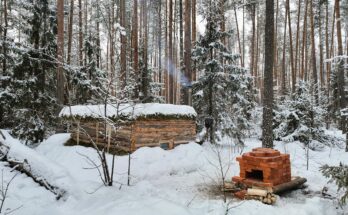
I never imagined that living underground would become more than just an experiment—it would become the scene of a life-changing moment. On what began as a typical day of working around my subterranean home, I found myself staring death in the face: a pair of wild bears charged at my property, and if not for the very shelter I built beneath the earth, I might not be telling this story today.
My home is not your average house. I designed and built an underground dwelling—part survival shelter, part intentional lifestyle choice—hoping to combine comfort, security, and a connection to the raw elements of nature. I chose a location, sunk into the landscape, layered the earth, and crafted the interior so that light, air, and insulation all worked together. I never considered that the real test of its worth would come not from weather or structural challenges, but from an encounter with one of nature’s most powerful predators: the bear.
The day began like many others. I was moving about the property, checking outdoor systems, and noticing subtle changes in the surrounding woods—broken branches, paw prints, that sense that something large had passed through. I brushed it off: wilderness animals are part of the process. But then came the sudden thunder of heavy footsteps and the unmistakable growl. Two bears—a sow and her cub, or perhaps two large males—I couldn’t tell in the moment—came out of the forest edge and headed straight for the house. Their speed and focus shook me to the core.
My heart slammed in my chest. Instinct told me: don’t run, don’t panic. The underground house had one entrance I’d reinforced, and I bolted toward it. The earth above felt like a shield; the thick walls muffled the noise and vibration of the bears crashing around the outside. As they circled, scratched, and roared at the door, I realized with growing relief that I was safe—for now. If I’d been in a conventional above-ground home, the scenario might have been vastly different.
Inside, I sat in the dimly lit tunnel of my shelter, listening to the bear’s growls vibrating through the structure. The world above seemed chaotic; the world beneath was calm. My preparation, my choice of building materials, the hidden entrance—all of it coalesced in that moment to protect me. After what felt like an eternity—though in reality it may have been only minutes—the bears retreated, their interest waning, likely because the perceived threat (me, silently observing) was too contained.
Emerging after the danger passed, I surveyed the scene: the forest margin slightly trampled, claw marks in the door framing, but no further damage. I realized then that this house had not just been a project or a novelty—it was my lifeline. That day, I learned several critical lessons.
First: the wild doesn’t negotiate. In building anywhere near wilderness habitat, you invite its inhabitants—sometimes predators. The bears didn’t care that I owned the land; they only cared about instinct and territory. Being prepared didn’t mean just having tools—it meant designing from the foundation for safety. The underground nature of the house made a huge difference in how I experienced the threat.
Second: fear is a signal. When I heard the footsteps, felt the ground tremble, recognized the growl—I knew something was very wrong. I didn’t freeze; I acted. I made my way into my shelter. I didn’t wait for the worst. You cannot assume “this won’t happen to me.” The moment of crisis is rare, but when it comes—you have to be ready.
Third: design matters. The decision to build underground was driven by many factors—energy efficiency, minimal visual impact, stability—but now I realize it also provided a kind of retreat from the primal. The earthen structure muffled sound, absorbed impact, and kept the house from being a direct target. Above ground, the door might have given way, or the panic might have triggered a worse outcome.
Fourth: survival is not just about equipment; it’s about mindset. I didn’t have a fight with a bear. I didn’t need to climb out a window or sprint into the woods. Instead I trusted the shelter, I trusted my own calm, and I trusted the fact that I had thought ahead. The best survival situations are the ones you never have to fight.
In the days after the incident, I made changes: added a secondary hidden exit, reinforced the entry framing further, and trimmed the surrounding shrubs to increase visibility. But I also took time to reflect. What was this about, beyond just one terrifying encounter? For me it became a story of living consciously, respecting nature’s power, and creating a home that is in harmony with both the land above and the earth beneath.
For anyone watching this story unfold (you’ll find the full video on YouTube via the link above), I hope two things: one, you appreciate how a life seemingly ordinary can turn extraordinary in seconds; and two, you consider how you might design your own living space—not just for comfort or aesthetics—but for resilience, for safety, and for alignment with the natural world.
When I look back on that day, I don’t dwell on the fear. I dwell on the gratitude. I’m grateful I chose to build this kind of house. I’m grateful I recognized the danger. I’m grateful I had the calm to trust the shelter’s protection. And I’m grateful I can share it with you. Because sometimes the stories we tell save more than just ourselves—they teach us how to live, how to prepare, and how to respect the wild unknown.
So, yes—on that day the bears almost killed me. But my underground house saved my life. And maybe, if you’re inspired by this, your own choices just might protect you, too.


